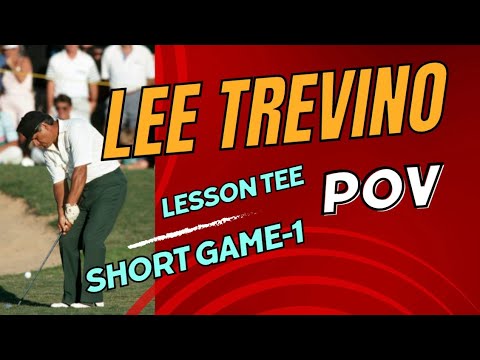💥 In this video, I break down Lee Trevino’s legendary open-faced pitch shot technique — and how it’s still used by modern pros like Jordan Spieth and Sahith Theegala.
You’ll see POV footage of me demonstrating the method, showing how to create spin, control trajectory, and build a short game you can trust under pressure.
🏌️♂️ Key topics in this video:
Lee Trevino’s body-driven pitching method
How to use your left hip to square the club face
Why this technique adds spin to open-faced shots
How players like Spieth and Theegala use similar moves
Insights from Short Game Chef, Joseph Mayo, and TPI
Practice drills to build consistency and feel
📽️ Filmed with POV camera angles so you can see the technique from the player’s view — perfect for understanding the movement and timing in real time.
Songs Credits:
Mellow Days by Pold / pold-music
Creative Commons — Attribution-ShareAlike 3.0 Unported — CC BY-SA 3.0
Free Download / Stream: https://audiolibrary.com.co/pold/mellow-days
Music promoted by Audio Library
Horizon by SEUBi / seubi123
Creative Commons — Attribution-NonCommercial-ShareAlike 3.0 Unported — CC BY-NC-SA 3.0
Free Download / Stream: https://audiolibrary.com.co/seubi/horizon
Music promoted by Audio Library
Drive by Mezhdunami
Creative Commons — Attribution 3.0 Unported — CC BY 3.0
Free Download / Stream: https://pixabay.com/music/synthwave-mezhdunami-drive-120288/
Music promoted by Audio Library
in in in pitching is like a tree. The body in pitching is like a tree. Okay. You have limbs. The limbs can’t move unless the trunk of the tree moves. If the limbs move without the trunk, you’re in deep trouble. Yeah. Just like this. Well, you’ve got no space. You see what I’m saying? You got to have space, right? This is what you have to do. The trunk has to move. The trunk has to move. Do you focus more in like your rib cage or are you focusing on that left hip? Only the hip. That’s what’s pulling the hand. And this guy will follow. It It’ll follow. It’s all the left hip. Even even even go here shorter. Watch. Wow. See that? Hey everyone, welcome back to the channel. So today I’m breaking down technique that’s as old as it is elite. Um Lee Trevino’s open face pitch shot has been a game changer for me personally. Um, it’s a a method that doesn’t look flashy, but when you look at the precise control and spin around the greens that he had, um, especially when short-sighted or trying to land softer, which is a huge challenge for a lot of us, um, because we just don’t have the time to see how everything reacts. Um, but I mean I was paying attention to how say modern players like Jordan Spith who play the low bumpy chunky type shot that still spins a lot, right? Um, then you have Sah uh Fagala who’s another good example of using pivot to do this, but the entry point’s a little different and it’s a little smoother. So, um, when when we looked at this kind of I thought maybe it’s better to kind of show you a POV view of what I’m doing or what I’m trying to do. And what you’ll notice here is that I’m pretty aggressive in going through the shot, but I don’t have like flash speed at the bottom. And a lot of that speed or that ball speed is taken off with the open face. Um, if you saw golf.com’s uh warm-ups with Trevino, there was a big um emphasis in about a kind of a short two-minute window where uh Trovino, excuse me, Trevino was emphasizing that a lot of players just don’t play with open face cuz it looks really awkward to them. They’re not they think it’s going to go 30° right of where they’re aiming for right-handed player. The truth is is that if you um lead with the hip and you’re not having to flip at it, um the ball will actually kind of start arcing toward your target because uh research shows that good players that set up correctly, that club is traveling a little bit more to the right than we think. Um and for such a short distance, unless you’ve got $100,000 of equipment, it’s really hard to track. So, um, you know, I wanted to kind of take a look at this because, um, my experiment of just, you know, just take a look at somebody who has a complete game and just use that as your basis for other aspects of your game. Like, if they figured it out and they figured out a method for you, uh, and your body type’s kind of similar and you just they got the flight that you want, easy money, right? So, um, when you take a look at a short shot like this one, um, the big thing here is entry point, right? And so, some of the things that help with this is that keeping your left foot or keeping your weight on your left side is not just like a suggestion, it’s like mandatory. And like when you the closer you get to the green, I’d say um the further left you want to feel or feel like this heaviness on the left side. Um and um on screen you’re kind of seeing me kind of messing around and seeing like some of the rule of 12 stuff. If you’ve never heard of that, really valuable stuff developed by Paul Renan back in the I don’t know 30s, 40s. Um, and so it probably should be rule of 13. Um, so I’m just covering a bunch of different things, but we’ll go further into it. Um, the more we, uh, do more of these videos, kind of starting to pick up the speed on the editing, um, I know a lot of these big YouTube channels, they have like editing teams. Um, so it’s just me kind of teaching myself how to do this. Um, so, um, the idea in this part of the video is one of the critical things about figuring out how to get a spinny flop shot to work. It’s very condition based, I think, I mean, you can do it and kind of force it, but the result is kind of mixed. And so, you need to really be good at reading the greens as you walk up. So right there on on screen, you’ll see that I have um light, dark, light. So the darker the green looks, the more into the grain, if you check it, the grain is going. And because we’re in Florida and we’ve got the the spongy stuff, the Bermuda, it’s really grabby. I’m getting a good I got a sprinkler behind. When it comes to chipping, if you land it on the light spot, expect it to hop faster and further forward. And if you’re running through any kind of grain, it’ll slow down for you. See how it released? If you land on the darker stuff, expect the hop to be a little bit tighter, which means in my in I guess in my jargon, um the ball will tend to hop less because it’s kind of got more cushion underneath to absorb some energy. And so when it hops back up, it’ll grab a little bit more. And then in my case, in that situation, um, you know, it it uh it did different things at different parts of the grain. So, this is the part of the video that you basically are here for based on our Instagram post about how to add spin to flop shots. Um, so one of the feels that I got from a VHS from Torino that he recorded I think in 86 I I believe. Um there’s a video I I’ll have to post that on the channel that uh where he’s facing a downhill lie and he’s got to add loft and spin really quickly to avoid having the ball the ball run off on him. And what he does is he takes his lead wrist and as he approaches the impact zone, he slows down and he acts like there’s like a wall right behind his forearm and his wrist. And that adds more speed at the bottom rather than trying to accelerate the entire um I don’t know apparatus unit whatever to excuse me to add your own speed to it. Now, what we’re trying to do is we’re trying to just slowly add speed where you need it. And a lot of that comes right at the ball. So, you’re not trying to flip on purpose. You’re actually leading with your body, but you’re hitting the brake slightly. And it’s almost like a driver move that people recommend when you’re trying to add vertical to your driver swing. Well, all you’re going to do is stay on your left side, pull back a little bit, and then you can let the club pass your arm. And what that does is allows you a little bit of forgiveness. Meaning, okay, if you stay on your left side and you keep your fulcrum, same idea, uh, your radius the same, when you come down and and hit the brakes on that lead on that lead hand, the weight of the club is going to shoot out a little bit to the right and catch the ball on the way up. And what this does is it speeds it up and it allows the club to slide down underneath the ball. Um, so, uh, and I used to think that, um, when you hit a flop shot, you have to lean back a little bit and maybe over swing some um, and do an off speed tempo. Personally, I’ve got three different and that just creates a lot of kind of hands at uh, I guess variance or variables worried about. Um, but with this technique, you’re basically going to use your standard chipping rhythm, big muscles. Um, one little tip for a chipping rhythm could be uh, you know, setup, uh, something with the right cadence. So, there was an old video, I think, from 2005. It was, I think VJ Singh and Rocki were talking on a range. Um, I think at a PGA open it event or fundraiser. I think it was in Houston. Um, and they talked about what do you use for rhythm or to practice rhythm. So um VJ would pick a number that had uh two syllables in the first number and then one syllable at the end. So 23 or you could think VJ sing easy, right? left. Uh, you use that same tempo, whatever that is for you personally, and you use your ball setup, chunky monkey, and your face setup to dictate how much energy you add or take away to the distance. um hit the green again. But when it comes to these kind of floppy um kind of high energy shots, probably the most important thing you could look at all the way there is your setup. Not just with how much the face is open or closed, but also where your hands are. So, uh, there’s a clinic where Trevorino talks about how he sets up for a full shot, and that was really helpful to get rid of the lefts. When I was learning how to not basically hook it 30 yards left or shoot it straight, you know, right into the pawns off the T- box. you you kind of have to know that part of the setup is kind of on the inside of your left shoulder and you have to have that shaft pointing at that inside of the shoulder. And you’ll see here toward the um end of the video I insert a couple of shots that I took of full swings um basically looking down at what the setup does. Now, here’s a really good uh look at one of these shots. And you see that it’s basically covering the left arch of my lead foot. And basically what I’m essentially saying to myself is that I’m going to hit this same location and that’s where I want the handle to exit. And now the full swing, it’s not that much different. The setup’s a little bit wider, but we can talk about that when we get into some full swing stuff. So um as far as you know I’m concerned like if you find a system that works I mean for you and you know it take any kind of system takes time to work on but if you find something um that works for you um and it doesn’t take a really long time to develop feel for it pursue Um, I’m not telling you that this is the way. This is a way. Um, if anyone tells you that this is the way and everyone else is wrong and it’s everyone else is making it too complex, golf is complex. Golf is like life. It’s just it’s not easy, but it’s getable if you put time into it and if you pick a system, it’ll work for you. And so my goal with this little video here is to kind of add a little more swagger when you get around the greens. Bring a little bit of that Tino essence to your game. You know, as long as you trust it, it’ll work for you. You can make it work for you. And I think one of the things that I love about taking some of that Trovino attitude is the swagger. So, cheers, amigos. Talk to you soon. Hey, so before I let you go, um, do me a favor, hit a like there, leave a comment, let me know if you’ve struggled with chipping or pitching. Um, and also leave a comment if you’ve tried it. Try this method. See if uh a little TVO swagger or some of this kind of modern explanation of the science behind it has helped you. Um, let me know. Cheers, amigos. [Music]







